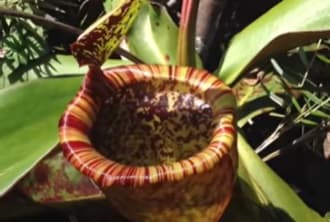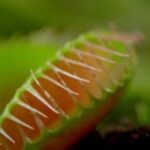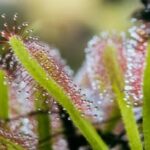As an Amazon Associate, this site earns commissions from qualifying purchases. For more details, click here.
Pitcher plants, known for their unique pitcher-shaped traps, are fascinating additions to indoor gardens. These carnivorous plants not only offer visual appeal but also serve as natural pest control. This guide shows you which pitcher plants you can grow indoors.
Key Takeaways:
- Pitcher plants offer a diverse range of options for indoor gardening, from tropical Nepenthes to cold-hardy Sarracenia.
- Each pitcher plant species has specific care requirements regarding light, humidity, and soil, which are essential to understand for successful cultivation indoors.
- With proper care and attention to their unique needs, pitcher plants can thrive indoors, providing both aesthetic beauty and natural pest control benefits.
Nepenthes (Tropical Pitcher Plants)
Nepenthes, commonly known as tropical pitcher plants, are renowned for their elegant pitchers filled with digestive fluids. Originating from tropical regions of Asia, Australia, and Madagascar, these plants are well-suited to indoor cultivation.
Varieties such as Nepenthes ventrata, Nepenthes alata, and Nepenthes x ‘Miranda’ are popular among indoor gardeners for their striking pitchers and ease of care.
When grown indoors, Nepenthes require bright, indirect light to thrive. Place them near a window where they can receive filtered sunlight or provide artificial grow lights to supplement natural light. Maintain high humidity levels by misting the foliage regularly or placing the plant on a humidity tray filled with water and pebbles.

Use a well-draining soil mix, such as a combination of sphagnum moss, perlite, and orchid bark, to ensure adequate moisture retention without waterlogging the roots. Water with distilled or rainwater to prevent mineral buildup, as Nepenthes are sensitive to salts and chemicals present in tap water.
Feeding Nepenthes can be challenging indoors, as they primarily rely on capturing live insects for nutrients. While they can survive on their own in favorable conditions, you may occasionally supplement their diet with small insects like fruit flies or houseflies to encourage growth and pitcher development.
Sarracenia (North American Pitcher Plants)
Sarracenia, native to North America, are another group of pitcher plants suitable for indoor gardening. These plants feature trumpet-shaped pitchers with vibrant colors and intricate veining, making them prized additions to any collection. Popular Sarracenia species include Sarracenia purpurea, Sarracenia leucophylla, and Sarracenia flava.
When grown indoors, Sarracenia thrive in bright, indirect light. Place them near a south-facing window where they can receive ample sunlight without direct exposure to intense midday sun. Maintain consistently moist soil by watering with distilled or rainwater as needed, ensuring that the soil remains evenly moist but not waterlogged.
Sarracenia undergo dormancy periods during winter, during which they require lower temperatures (around 40-50°F or 4-10°C) and reduced watering to simulate their natural habitat conditions. During dormancy, pitchers may wither and die back, but new growth will emerge once dormancy ends in spring.
Cephalotus follicularis (Australian Pitcher Plant)
Cephalotus follicularis, also known as the Australian pitcher plant or Albany pitcher plant, is a unique carnivorous plant prized for its compact size and intricate pitchers. Native to southwestern Australia, Cephalotus follicularis adapts well to indoor cultivation under the right conditions.
This plant prefers cool temperatures, ideally between 50-70°F (10-21°C), making it suitable for temperate indoor environments. Place it in a bright location with indirect sunlight, such as a south-facing window with sheer curtains to filter the light.
Avoid exposing Cephalotus follicularis to direct sunlight, as it can scorch the delicate pitchers. Use a well-draining soil mix consisting of peat moss, perlite, and sand to provide adequate moisture retention while preventing waterlogging.
Unlike other pitcher plants, Cephalotus follicularis doesn’t rely solely on pitcher traps for prey capture. Instead, it utilizes sticky glandular leaves to catch insects, supplementing its diet with additional nutrients. Provide occasional feeding with small insects like fruit flies or pinhead crickets to support growth and pitcher development.
Heliamphora (Sun Pitcher Plants)
Heliamphora, commonly known as sun pitcher plants, are native to the highlands of South America. These plants feature tall, elegant pitchers adapted to capture insects in their natural habitat. While they require specific conditions to thrive, certain Heliamphora species can be grown successfully indoors with proper care.
Heliamphora thrive in cool temperatures, ideally between 60-70°F (15-21°C), making them suitable for temperate indoor environments. Provide bright, indirect light by placing them near a south-facing window with sheer curtains or using artificial grow lights to supplement natural light.
Maintain high humidity levels by misting the foliage regularly or using a humidifier to create a humid microclimate around the plant. Use a well-aerated growing medium, such as a mix of sphagnum moss and perlite, to mimic their native bog habitats while ensuring adequate drainage.
Feeding Heliamphora can be challenging indoors, as they primarily rely on capturing live insects for nutrients. While they can survive on their own in favorable conditions, you may occasionally supplement their diet with small insects like fruit flies or wingless fruit flies to encourage growth and pitcher development.
How Long Do Pitcher Plants Take to Grow?
The time it takes for pitcher plants to grow indoors can vary depending on several factors, including the species of pitcher plant, environmental conditions, and the plant’s age when initially acquired. In general, pitcher plants are relatively slow-growing compared to many other houseplants.
It may take several months to a few years for pitcher plants to reach maturity and develop fully-formed pitchers indoors. However, with optimal care, including providing adequate light, humidity, and watering, you can encourage healthy growth and expedite the development of new pitchers. Additionally, some pitcher plant species, such as Nepenthes, tend to grow more rapidly than others, such as Sarracenia, which typically have slower growth rates.
Indoor Pitcher Plants and Grow Lights
While natural sunlight is optimal for plant growth, many indoor environments may lack sufficient light for growing pitcher plants. In such cases, artificial lighting can be a valuable supplement or alternative to ensure healthy growth and development.
Types of Artificial Lights
LED Grow Lights: LED (Light Emitting Diode) grow lights are energy-efficient and versatile options for indoor gardening. They emit specific wavelengths of light that cater to the needs of plants, including pitcher plants. LED grow lights come in various spectrums, including full-spectrum, which mimic natural sunlight and promote robust growth and pitcher development.
Fluorescent Grow Lights: Fluorescent lights, such as T5 and T8 tubes, are another popular choice for indoor plant cultivation. They provide a balanced spectrum of light suitable for promoting healthy growth in pitcher plants. Fluorescent lights are cost-effective and emit low heat, making them suitable for use in confined indoor spaces.
High-Intensity Discharge (HID) Lights: HID lights, including Metal Halide (MH) and High-Pressure Sodium (HPS) lamps, are powerful lighting options favored by some indoor gardeners. While they produce intense light output, HID lights can generate significant heat and may require additional cooling measures to prevent overheating.
Placement of Lights
When using artificial lights to grow pitcher plants indoors, proper placement is essential for maximizing light exposure and promoting uniform growth. Position the lights overhead or at an angle to ensure even distribution of light across the entire plant canopy.
Adjust the height and distance of the lights based on the specific light requirements of your pitcher plant species, as well as the intensity and coverage of the artificial lights.
Light Duration and Intensity
Pitcher plants require adequate light exposure to thrive indoors, but excessive light intensity or duration can lead to issues such as leaf burning or stunted growth. Generally, provide pitcher plants with 10 to 14 hours of light per day to mimic natural daylight conditions. Adjust the intensity and duration of artificial lights based on factors such as the plant’s growth stage, species, and environmental conditions.
Supplemental Lighting
In addition to artificial lights, consider supplementing natural light with other light sources, such as grow tents or reflective surfaces, to maximize light penetration and efficiency. Reflective materials, such as Mylar or white-painted walls, can help redirect and diffuse light to reach areas of the plant that may receive less direct light.
Monitoring and Adjustments
Regularly monitor your pitcher plants for signs of light stress or deficiencies, such as yellowing or bleaching of leaves. Adjust the positioning, intensity, and duration of artificial lights as needed to optimize plant health and growth. Remember that each pitcher plant species may have specific light requirements, so it’s essential to tailor your lighting setup accordingly.
:
Artificial lights can be invaluable tools for cultivating healthy and thriving pitcher plants indoors, especially in environments with limited natural sunlight. By selecting the appropriate types of lights you can create an ideal growing environment.
The right lights also promotes robust growth and vibrant pitcher development year-round. With proper care and attention to lighting needs, your indoor pitcher plants can flourish and thrive, bringing beauty and fascination to your indoor garden.
Conclusion
Pitcher plants offer a captivating glimpse into the world of carnivorous plants, making them popular choices for indoor gardening enthusiasts. Whether you’re drawn to the tropical elegance of Nepenthes, the vibrant colors of Sarracenia, the compact charm of Cephalotus follicularis, or the sleek beauty of Heliamphora, there’s a pitcher plant variety to suit every indoor garden.
By understanding the unique characteristics and care requirements of different pitcher plant species, you can create a thriving indoor garden filled with these fascinating carnivorous plants. With proper care and attention, your pitcher plants will reward you with their stunning beauty and natural pest control capabilities for years to come.

My fascination with carnivorous plants began many, many years ago with Venus Fly Traps. Now I am more than happy to impart what I know with other enthusiasts and those who are curious about meat eating plants.


